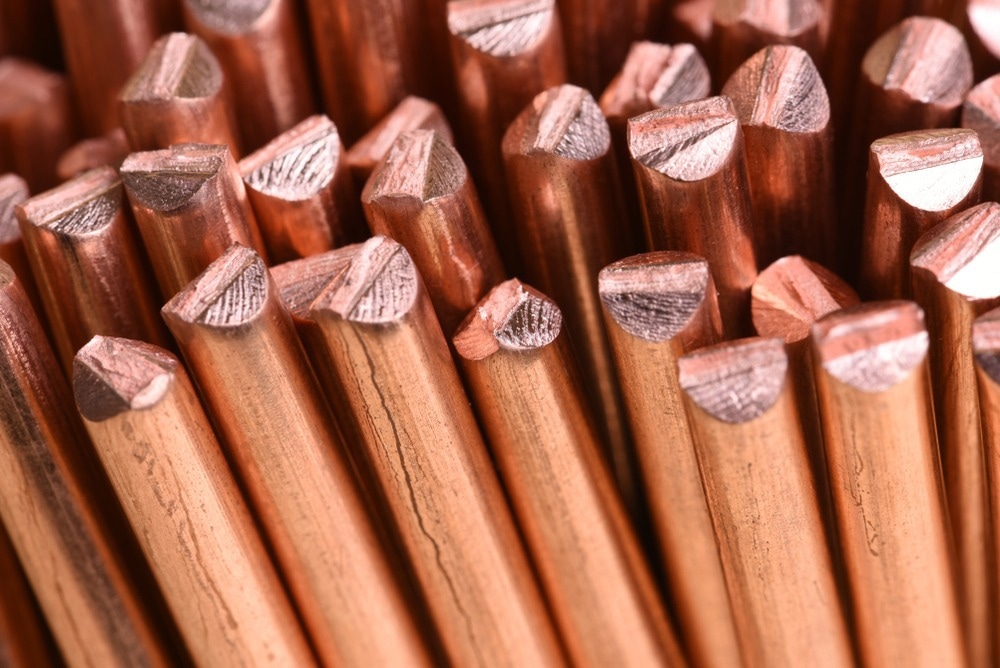Updated by Reginald Davey 23/09/22
Copper (I) oxide, otherwise known as cuprous oxide or copper 1 oxide, is an inorganic compound with the formula Cu2O. It is a principal oxide of copper. This compound is a red-colored solid, and is a main component of certain antifouling paints. The compound may be red or yellow based on the particle size.

Image Credit: Flegere/Shutterstock.com
Description
Applications
Chemical Properties
Electrical Properties
Thermal, Mechanical and Optical Properties
Safety Information
Copper(I) oxide is found as the reddish mineral cuprite. Cu2O crystallizes in a cubic structure having a lattice constant al = 4.2696 Å. The copper atoms arrange themselves in an fcc sub-lattice and the O atoms in a bcc sub-lattice. Cu2O is probably the most studied semiconductor and a number of semiconductor applications were first demonstrated using this material.
Preparation of Copper 1 Oxide
Copper (I) oxide is commonly prepared by the straightforward oxidation of copper metal. The process can be affected by additives such as acids and water, and further oxidation to copper (II) oxide can occur during preparation. Another preparation route is the copper (II) oxide reduction.
Applications
Cuprous oxide is used commonly as a fungicide, a pigment, and an antifouling agent for marine plants. Rectifier materials based on this material have been industrially used as early as 1924 long before silicon was made a standard.
Copper (I) oxide has been widely used in the shipbuilding industry as a coating for the hulls of ships to prevent seawater corrosion due to its anti-corrosion properties.
Another application is in the Benedict’s test. This test helps detect the presence of sugars having a free ketone or an aldehyde group. All monosaccharides have a free reactive carbonyl group and are reducing sugars. Disaccharides such as sucrose are non-reducing sugars and do not react with benedict’s solution. The copper sulfate in Benedict’s solution reacts with electrons from the ketone or the aldehyde group to form a red-brown precipitate copper oxide. The solution’s final color decides how much reducing sugar is present.
Copper (I) oxide is used in a wide variety of cutting-edge industrial applications. The material is commonly employed in semiconductors such as p-type semiconductors and high-tech superconductors. It can also be employed in thermoelectric materials, catalysts, sensors, and ceramics.
More from AZoM: Copper II Oxide ( CuO ) - Supplier Data by Goodfellow
An innovative use of copper (I) oxide was revealed by Toshiba in December 2021. The company unveiled a revolutionary transparent cuprous oxide-based thin-film solar cell. These solar cells achieved an energy conversion efficiency of 8.4%, which is the highest reported efficiency thus far. The device has been proposed for use in electric vehicles and high-altitude platforms and provides benefits over conventional photovoltaic solar cell technologies.
Cu2O as a Semiconductor: Some Technical Perspectives
Copper (I) oxide has several beneficial properties as a semiconductor material. In the history of semiconductor physics, it has been one of the most widely studied materials. Indeed, several innovative experimental semiconductor advances were first demonstrated using copper (I) oxide.
Copper (I) oxide displays the narrowest observed bulk exciton response out of any semiconductor material. High polariton densities have been observed due to their low group velocities, which are close to the speed of sound. In essence, light moves as slowly as sound in copper (I) oxide semiconductor media. Research into this material has demonstrated that polaritons are not governed by Kramers-Kronig relations.
Chemical Properties
The chemical properties of copper(I) oxide are provided in the table below:
| Chemical Properties |
| Chemical Formula |
Cu2O |
| Molecular Weight |
143.09 |
| CAS No. |
1317-39-1 |
| Group |
Copper – 11
Oxygen - 16 |
| Crystal Structure |
Cubic |
| Lattice Constant |
4.2696 Å |
Electrical Properties
The electrical properties of copper(I) oxide are provided in the table below:
| Electrical Properties |
| Dielectric Constant |
18.1 |
| Band Gap |
2.137 eV |
Thermal, Mechanical and Optical Properties
The thermal and mechanical properties of copper(I) oxide are provided in the tables below:
| Thermal Properties |
| Heat of Formation |
-170 kJ/mol |
| Mechanical Properties |
| Melting Point |
1232°C |
| Density |
6.0 g/cm3 |
Safety Information
| Safety Information |
| GHS Hazard Statements |
H302 – Harmful if swallowed
H410 – Very toxic to aquatic life with long lasting effects |
| Safety Precautions |
S 22 – Do not breathe dust
S 60 - This material and its container must be disposed of as hazardous waste
S 61 - Avoid release to the environment. Refer to special instructions/safety data sheet |
Disclaimer: The views expressed here are those of the author expressed in their private capacity and do not necessarily represent the views of AZoM.com Limited T/A AZoNetwork the owner and operator of this website. This disclaimer forms part of the Terms and conditions of use of this website.